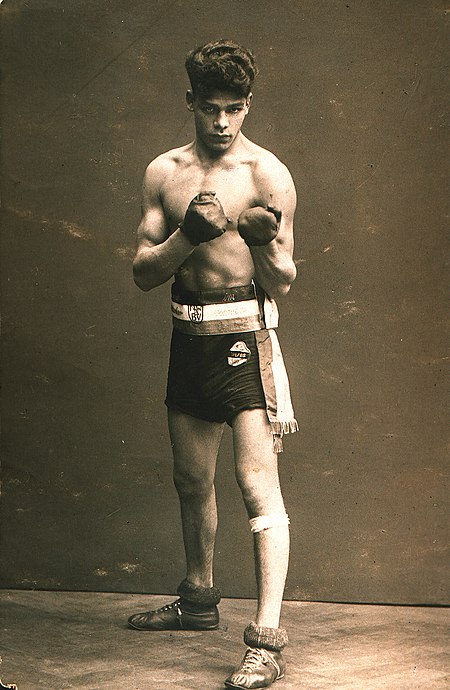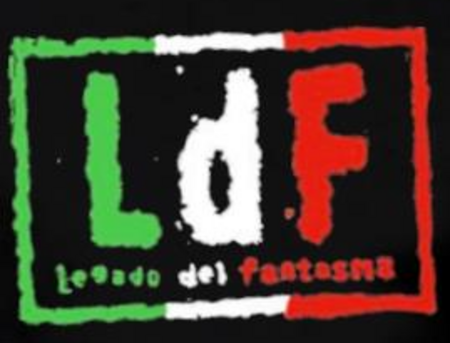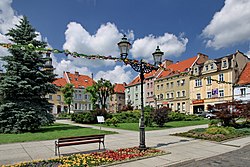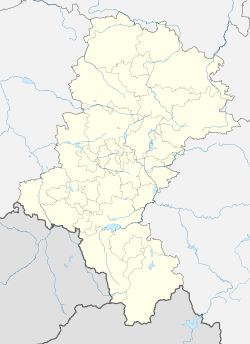Wodzisław Śląski
| |||||||||||||||||||||||||||||||||||||||||||||||
Read other articles:

此條目需要补充更多来源。 (2021年7月4日)请协助補充多方面可靠来源以改善这篇条目,无法查证的内容可能會因為异议提出而被移除。致使用者:请搜索一下条目的标题(来源搜索:美国众议院 — 网页、新闻、书籍、学术、图像),以检查网络上是否存在该主题的更多可靠来源(判定指引)。 美國眾議院 United States House of Representatives第118届美国国会众议院徽章 众议院旗帜…
2020年夏季奥林匹克运动会波兰代表團波兰国旗IOC編碼POLNOC波蘭奧林匹克委員會網站olimpijski.pl(英文)(波兰文)2020年夏季奥林匹克运动会(東京)2021年7月23日至8月8日(受2019冠状病毒病疫情影响推迟,但仍保留原定名称)運動員206參賽項目24个大项旗手开幕式:帕维尔·科热尼奥夫斯基(游泳)和马娅·沃什乔夫斯卡(自行车)[1]闭幕式:卡罗利娜·纳亚(皮划艇)[2…

Bagian dari seri mengenai Sejarah Afganistan Garis Waktu Kuno Peradaban Lembah Sungai Indus 2200–1800 SM Peradaban Oxus 2100–1800 SM Kerajaan Gandhara 1500–535 SM Kekaisaran Media 728–550 SM Kekaisaran Akhemeniyah 550–330 SM Kekaisaran Seleukia 330–150 SM Kekaisaran Maurya 305–180 SM Kerajaan Yunani-Baktria 256–125 SM Kekaisaran Parthia 247 SM–224 AD Kerajaan Indo-Yunani 180–130 SM Kerajaan Indo-Skhitia 155–80? SM Kekaisaran Kushan 135 SM – 248 AD Indo-Parthian Kingdom 20…

Governing elite in Argentina from 1880 to 1916 El General Roca ante el Congreso Nacional (c. 1886–1887) by Juan Manuel Blanes The Generation of '80 (Spanish: Generación del '80) was the governing elite in Argentina from 1880 to 1916. Members of the oligarchy of the provinces and the country's capital, they first joined the League of Governors (Liga de Gobernadores), and then the National Autonomist Party, a fusion formed from the two dominating parties of the prior period, the Autonomist Part…

Artist and painter (1942–2016) Eugeniusz Geno MalkowskiBorn(1942-09-05)5 September 1942Gdynia, PolandDied20 August 2016(2016-08-20) (aged 73)Zamość, PolandNationalityPolishEducationJuliusz StudnickiArtur Nacht-SamborskiKnown forPaintingMovementLyrical abstractionabstract expressionismAwards Eugeniusz Geno Małkowski (Polish pronunciation: [ɛuˈɡɛɲuʂ ˈɡɛnɔ mauˈkɔfski]; 5 September 1942 – 20 August 2016) was a Polish painter. Małkowski was a professor of contemp…

1973 Piper twin-engined, six-seat cabin aircraft PA-40 Arapaho Role Twin-engined cabin monoplaneType of aircraft National origin United States Manufacturer Piper First flight 16 January 1973 Status Cancelled Number built Three Developed from Piper PA-39 Twin Comanche The Piper PA-40 Arapaho was an American twin-engined cabin monoplane designed by Piper as a replacement for the PA-39 Twin Comanche C/R.[1] Like most Piper products at this time, the PA-40 was named after a Native American t…

Philosophy Template‑class Philosophy portalThis template is within the scope of WikiProject Philosophy, a collaborative effort to improve the coverage of content related to philosophy on Wikipedia. If you would like to support the project, please visit the project page, where you can get more details on how you can help, and where you can join the general discussion about philosophy content on Wikipedia.PhilosophyWikipedia:WikiProject PhilosophyTemplate:WikiProject PhilosophyPhilosophy article…

This article needs additional citations for verification. Please help improve this article by adding citations to reliable sources. Unsourced material may be challenged and removed.Find sources: Buddhism in Austria – news · newspapers · books · scholar · JSTOR (March 2008) (Learn how and when to remove this message) Overview of the role of Buddhism in Austria Part of a series onBuddhism Glossary Index Outline History Timeline The Buddha Pre-sectarian Budd…

Kentucky gubernatorial election 1792 Kentucky gubernatorial election 17 May 1791 1796 → Nominee Isaac Shelby Party Democratic-Republican Popular vote 1 Percentage 100.00% Governor before election Office Established Elected Governor Isaac Shelby Democratic-Republican Elections in Kentucky Federal government Presidential elections 1792 1796 1800 1804 1808 1812 1816 1820 1824 1828 1832 1836 1840 1844 1848 1852 1856 1860 1864 1868 1872 1876 1880 1884 1888 1892 1896 1900 1904 1…

一般国道 国道332号 地図 総延長 3.9 km 実延長 3.0 km 現道 3.0 km 制定年 1972年(昭和47年) 起点 沖縄県那覇市那覇空港(北緯26度12分13.61秒 東経127度39分9.61秒 / 北緯26.2037806度 東経127.6526694度 / 26.2037806; 127.6526694) 終点 沖縄県那覇市明治橋(北緯26度12分28.56秒 東経127度40分27.88秒 / 北緯26.2079333度 東経127.6744111度 / 26.2079333; 127.6744111 (明治�…

Sinti dan orang-orang Roma, 1941 Johann Trollmann, petinju Sinti Jerman Sinti (juga Sinta atau Sinte; maskulin. tunggal. Sinto; feminin. tunggal. Sintesa) adalah orang-orang Rom di Eropa Tengah.[1] Mereka secara tradisional hidup berkeliling mengembara atau disebut gipsi, tetapi sekarang hanya sebagian kecil dari Sinti yang berpola hidup seperti itu. Pada zaman dahulu, mereka sering tinggal di pinggiran komunitas. Sinti Eropa Tengah terkait erat dengan kelompok yang dikenal sebagai Manou…

Professional wrestling stable Professional wrestling stable Legado Del FantasmaThe logo as Legado Del Fantasma - inspired by the Latino World Order stable.StableMembersSantos Escobar (leader)Elektra LopezAngelBertoName(s)Legado Del FantasmaBilled heightsEscobar: 6 ft 1 in (1.85 m)Angel: 5 ft 9 in (1.75 m)Berto: 6 ft 1 in (1.85 m)Lopez: 5 ft 8 in (1.73 m)Combinedbilled weight762 lb (346 kg)Formermember(s)Joaquin WildeRaul Mendo…

1971 studio album by Elvis PresleyElvis Country (I'm 10,000 Years Old)Studio album by Elvis PresleyReleasedJanuary 7, 1971[1]RecordedJune 4–8 and September 22, 1970StudioRCA Studio B (Nashville)Genre Country country rock rock and roll Length38:49LabelRCA VictorProducerFelton JarvisElvis Presley chronology That's the Way It Is(1970) Elvis Country (I'm 10,000 Years Old)(1971) You'll Never Walk Alone(1971) Singles from Elvis Country I Really Don't Want to KnowReleased: December 8,…

American sign company This article may contain excessive or inappropriate references to self-published sources. Please help improve it by removing references to unreliable sources where they are used inappropriately. (February 2023) (Learn how and when to remove this message) Daktronics, Inc.Company typePublicTraded asNasdaq: DAKTIndustryElectronicsFounded1968; 56 years ago (1968)[1]FounderAelred J. KurtenbachDuane SanderHeadquartersBrookings, South Dakota, United …

Paola PitagoraPaola Pitagora dalam I pugni in tasca (1965).Lahir24 Agustus 1941 (umur 82)Parma, ItaliaNama lainPaola GargeloniPekerjaanPemeranTahun aktif1959-kini Paola Pitagora (lahir 24 Agustus 1941) adalah seorang pemeran film asal Italia. Ia tampil dalam 50 film sejak tahun 1959. Filmografi pilihan Shots in Threequarter Time (1965) Fists in the Pocket (1965) Pardon, Are You for or Against? (1966) Death on the Run (1967) The Girl Who Couldn't Say No (1968) In Search of Gregory …

Archaeological site in Uzbekistan VarakhshaRuins of VarakhshaShown within West and Central AsiaShow map of West and Central AsiaVarakhsha (Uzbekistan)Show map of UzbekistanAlternative nameVarakhshaLocationUzbekistanCoordinates39°51′49″N 64°04′23″E / 39.86361°N 64.07306°E / 39.86361; 64.07306TypeSettlementSite notesConditionRuined Varakhsha, also Varasha or Varahsha, was an ancient city in the Bukhara oasis in Sogdia, founded in the 1st century BCE.[1&…

You can help expand this article with text translated from the corresponding article in Belarusian. (March 2020) Click [show] for important translation instructions. Machine translation, like DeepL or Google Translate, is a useful starting point for translations, but translators must revise errors as necessary and confirm that the translation is accurate, rather than simply copy-pasting machine-translated text into the English Wikipedia. Do not translate text that appears unreliable or low-…

Cet article est une ébauche concernant le catch. Vous pouvez partager vos connaissances en l’améliorant (comment ?) selon les recommandations des projets correspondants. WWE United States Championship Logan Paul, l'actuel champion. Données générales Autres noms NWA United States Heavyweight Championship (Mid-Atlantic)WCW United States Heavyweight ChampionshipWCW Canadian Heavyweight ChampionshipWCW United States Championship Création 1er janvier 1975 Fédération NWA (1975–1988)WC…

Gregorian calendar as it is in use in Ireland Not to be confused with Public holidays in the Republic of Ireland. This article or section possibly contains synthesis of material which does not verifiably mention or relate to the main topic. Relevant discussion may be found on the talk page. (June 2015) (Learn how and when to remove this message) The factual accuracy of part of this article is disputed. The dispute is about not reflecting the continued use of these seasons in modern-day Ireland (…

2009 film by John Lee Hancock This article is about the 2009 film. For the 1986 film, see Blindside (film). For the 1993 film, see Blind Side (1993 film). The Blind SideTheatrical release posterDirected byJohn Lee HancockScreenplay byJohn Lee HancockBased onThe Blind Side: Evolution of a Gameby Michael LewisProduced by Broderick Johnson Andrew Kosove Gil Netter Starring Sandra Bullock Tim McGraw Quinton Aaron Kathy Bates CinematographyAlar KiviloEdited byMark LivolsiMusic byCarter BurwellProduct…


















